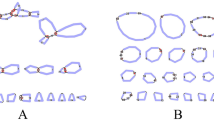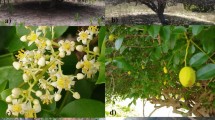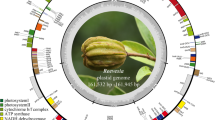Abstract
St Helena is an endemic rich but ecologically devastated island in the South Atlantic Ocean. Many of the endemic plants are extinct or critically endangered. The genus Wahlenbergia is an example. Two species are extinct, one species critically endangered (population <50: Wahlenbergia linifolia) and one species vulnerable (population c. 8800: Wahlenbergia angustifolia). Gene flow between these two remaining species has been suspected. To aid parental analysis of these ultra-rare endemics we used whole genome sequencing to generate large plastome contigs from two individuals of W. angustifolia. These were then used to develop sufficient plastid markers (indels, snps and microsatellites) to enable discrimination of plastotypes within and between species. Ten polymorphic plastid indels ranging between 7 and 19 bp along with three microsatellites and one SNP were selected using this next generation sequencing approach. Nine W. angustifolia and 35 W. linifolia plants were scored for these markers. Seven species-specific markers were found of which five were indels. We identified eight plastotypes within W. angustifolia and one plastotype in W. linifolia. Preliminary results indicate that gene flow has occurred between the two species. The results show the ease with which highly variable plastid markers can be found using next generation sequencing. The indel markers are particularly valuable as these can be scored using cheap and safe agarose gels. The markers will help generate breeding system data that is of direct relevance for the conservation of these species.
Similar content being viewed by others
References
Cronk QCB (1989) The past and present vegetation of St Helena. J Biogeogr 16:47–64
Cronk QCB (2000) The endemic flora of St Helena. Anthony Nelson Ltd, Oswestry
Doyle JJ, Doyle JL (1987) A rapid DNA isolation procedure for small quantities of fresh leaf tissue. Phytochem Bull 19:11–15
Frankham R (2015) Genetic rescue of small inbred populations: meta-analysis reveals large and consistent benefits of gene flow. Mol Ecol 24:2610–2618
Hall T (2004) BioEdit version 7.0.0. http://www.mbio.ncsu.edu/bioedit/biodoc.pdf
Hamilton JA, Miller JM (2016) Adaptive introgression as a resource for management and genetic conservation in a changing climate. Conserv Biol 30:33–41
Kane N, Sveinsson S, Dempewolf H, Yang JY, Zhang D, Engels JMM, Cronk QC (2012) Ultra-barcoding in cacao (Theobroma spp.; Malvaceae) using whole chloroplast genomes and nuclear ribosomal DNA. Am J Bot 99:320–329
Lambdon PW, Ellick S (2016a) Wahlenbergia linifolia. The IUCN red list of threatened species 2016: e.T44010A67371678. Online database accessed July 2016.
Lambdon PW, Ellick S (2016b) Wahlenbergia angustifolia. The IUCN red list of threatened species 2016: e.T43988A67371447. Online database accessed July 2016.
Peakall R, Smouse PE (2006) Genalex 6: genetic analysis in excel. Population genetic software for teaching and research. Mol Ecol Notes 6:288–295
Rozen S, Skaletsky HJ (2000) Primer3 on the WWW for general users and for biologist programmers. In: Krawetz S, Misener S (eds) Bioinformatics methods and protocols: methods in molecular biology. Humana Press, New Jersey, pp 365–386
Todesco M, Pascual MA, Owens GL, Ostevik KL, Moyers BT, Hübner S, Heredia SM, Hahn MA, Caseys C, Bock DG, Rieseberg LH (2016) Hybridization and extinction. Evol Appl. doi:10.1111/eva.12367
Yang JY, Motilal LA, Dempewolf H, Maharaj K, Cronk QCB (2011) Chloroplast microsatellite primers for cacao (Theobroma cacao) and other Malvaceae. Am J Bot 98:e372–e374
Yang JY, Scascitelli M, Motilal LA, Sveinsson S, J. M. M. Engels, Kane NC, Dempewolf H, Zhang D, Maharaj K, Cronk QCB (2013) Complex origin of Trinitario-type Theobroma cacao (Malvaceae) from Trinidad and Tobago revealed using plastid genomics. Tree Genet Genomes 9:829–840
Acknowledgments
We gratefully acknowledge the generous support of the Mohammed Bin Zayed Foundation (project number 12254442), for funding the original surveys by PL and the collection of the DNA samples. We also thank the numerous people in St Helena who aided and supported this study, especially Rebecca Cairns-Wicks (St Helena National Trust). We also thank Andrea Stevenson for assisting with the DNA extraction. Molecular work was funded by Natural Sciences and Engineering Research Council of Canada (NSERC) funding to QC under the Discovery Grants Program (Grant No. RGPIN-2014-05820).
Author information
Authors and Affiliations
Corresponding author
Rights and permissions
About this article
Cite this article
Yang, J.Y., Lambdon, P., Williams, V. et al. Plastid markers from whole plastome sequencing for gene-flow studies in the endangered endemic bellflowers of St Helena, Wahlenbergia angustifolia and Wahlenbergia linifolia (Campanulaceae). Conservation Genet Resour 9, 131–137 (2017). https://doi.org/10.1007/s12686-016-0612-1
Received:
Accepted:
Published:
Issue Date:
DOI: https://doi.org/10.1007/s12686-016-0612-1




